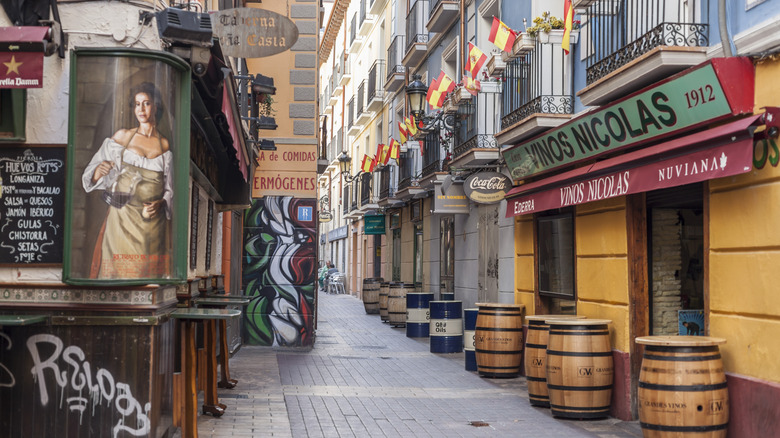Halfway Between Madrid And Barcelona Is A Spanish City With Astonishing Architecture And Gastronomy
Being a country's fifth-largest city is hardly a claim to fame, so it's no surprise Zaragoza often gets passed over on many people's travel itineraries. Most visitors opt for the sprawling Madrid and Barcelona. Since Spain is the absolute best country in Europe for road trips, you can incorporate a stop between the two hubs in Zaragoza. The city offers beautiful scenery and local gastronomy influenced by the surrounding regions of Catalonia, Navarra, and La Rioja.
You'll have no problem getting to Zaragoza from Madrid or Barcelona using public transportation either. High-speed AVE trains travel from both cities and take about 1.5 hours each way, with the cheapest fares ranging from $20 to $8 at the time of this publication. Regional trains and buses can also get you there in around four hours. However, if using public transport, know that Spain is experiencing record-breaking travel this summer, so there are some things to keep in mind.
Thanks to its scenic (and strategic) location on the River Ebro, Zaragoza changed hands a number of times through Roman, Muslim, and finally Catholic conquest, when it became the capital of the Kingdom of Aragón. Architectural gems scattered about town tell the city's story, while local cuisine reflects the rustic and hearty flavors traditional to the region's rough peaks and valleys. There are plenty of chances to taste its highlights in the local tapas district.
What to see in and around Zaragoza
To truly grasp the breadth of Zaragoza's cultural influences over time, turn to its buildings. To the west of Old Town, the Aljafería Palace (which housed both sultans and Catholic kings in succession) offers a glimpse at ornate Islamic architecture, comparable to the Alhambra of Granada in some aspects. The fort's turreted walls and alabaster carvings within its Golden Hall are particularly pretty. La Seo, or the Cathedral of San Salvador, is an example of the UNESCO-listed Mudejar architecture of Aragon, with fine geometric brickwork walls and an elaborate altarpiece. The riverfront Basílica del Pilar looks like a Disney castle, featuring rounded pinnacles. An important pilgrimage destination, the cathedral is built where the Virgin Mary is said to have appeared to James the Apostle.
Along with its city walls, which surround a 2-mile perimeter of the Old Town, you can see the remains of the Roman Caesaraugusta, including the ancient forum, public baths, river port, and theater. The pilgrimage to see all of these is known as the Caesaraugusta Route. The Rococo and moody stylings of Francisco Goya, who was considered a key player in the development of modern art, are immortalized at the Museo Goya nearby, although it is currently closed for renovations at the time of this writing.
If you're planning on road-tripping to Zaragoza, you can make nearby detours to iconic places in the region. Check out breathtaking waterfalls, hiking trails, and glaciers in Ordesa y Monte Perdido National Park, where rugged peaks line the French border just two hours north of Zaragoza. About two hours south of the city, you could continue exploring Aragón's culture and cuisine in Teruel, an underrated Spanish city with an artistic legacy and culinary charm.
Discover Aragonese tapas in El Tubo
On the south side of Old Town, El Tubo (or "The Tube") district holds the key to Zaragoza's taste buds. The crowded front windows and vestibules of tapas bars line this tightly connecting network of narrow alleyways. And most delightful of all, many specialize in their own unique branch of local cuisine. El Champi ZGZ serves juicy mushrooms stacked on sliders and skewers, La Migueria features the local style of migas (a fried bread crumb dish) with your choice of pork belly, chorizo, grapes, or blood sausage, and La Flor de Lis is an upscale eatery with contemporary takes on Aragonese dishes.
There are also several spots in El Tubo that serve ternasco de Aragón, a local method of preparing a roast lamb that has grazed on local herbs like rosemary and thyme. Like many Spaniards, people from Aragón love their vermouth, so be sure to try some of the local distillates at a vermutería. Just remember to time your visits around siesta hours, and consider how this afternoon tradition can affect your vacation.


